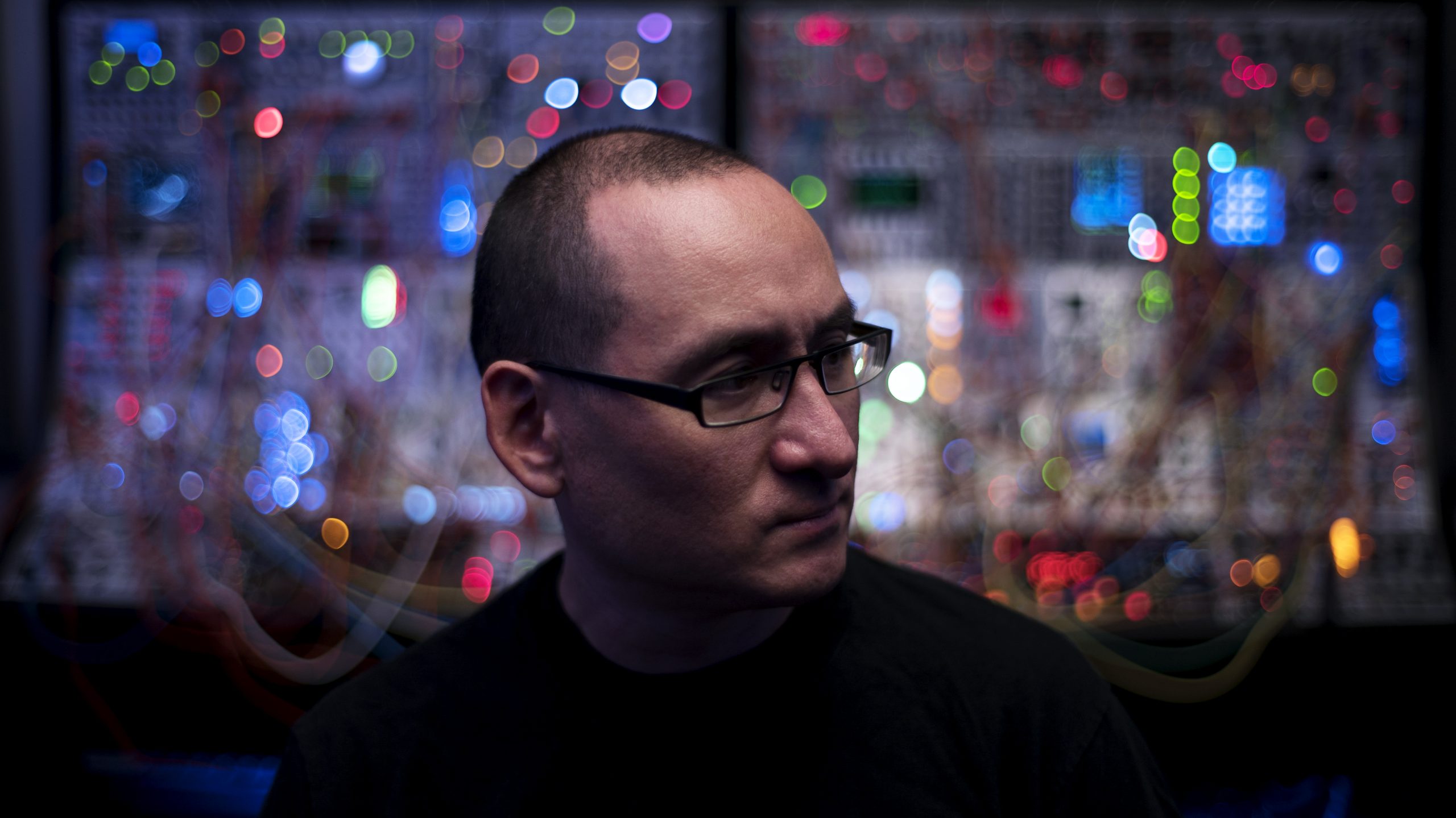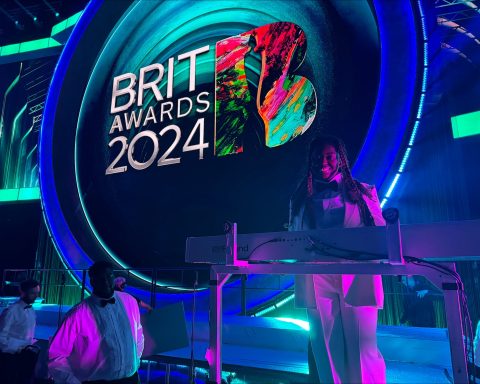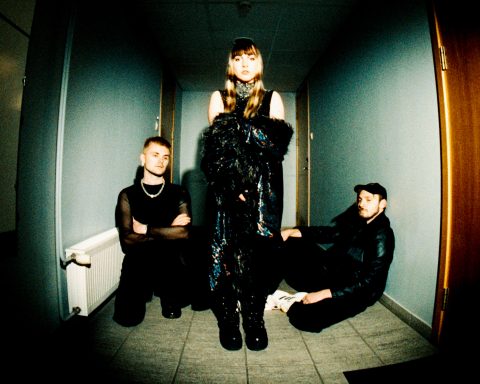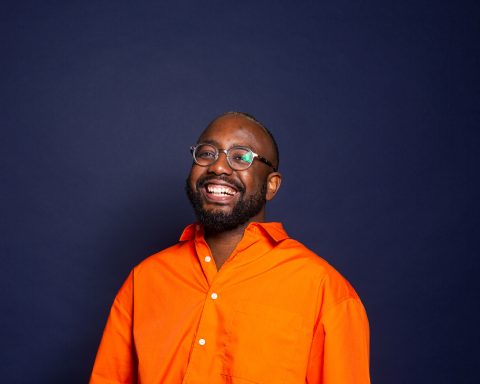When it comes to electronics, music, and media, there’s little Richard Devine hasn’t touched in his career. Even with a discography like his, Devine’s latest release Systic is a highlight. Recorded live, tracks like “5shim” and “Entcid” are genre-blasting workouts. Systic stands firmly on the shoulders of acid. At the same time, the EP reanimates the sound, twisting it into a new experimental form. Call it 303 jazz. The prolific Devine took the time to speak with us about his childhood, sound design, and creating his new EP using Roland instruments.
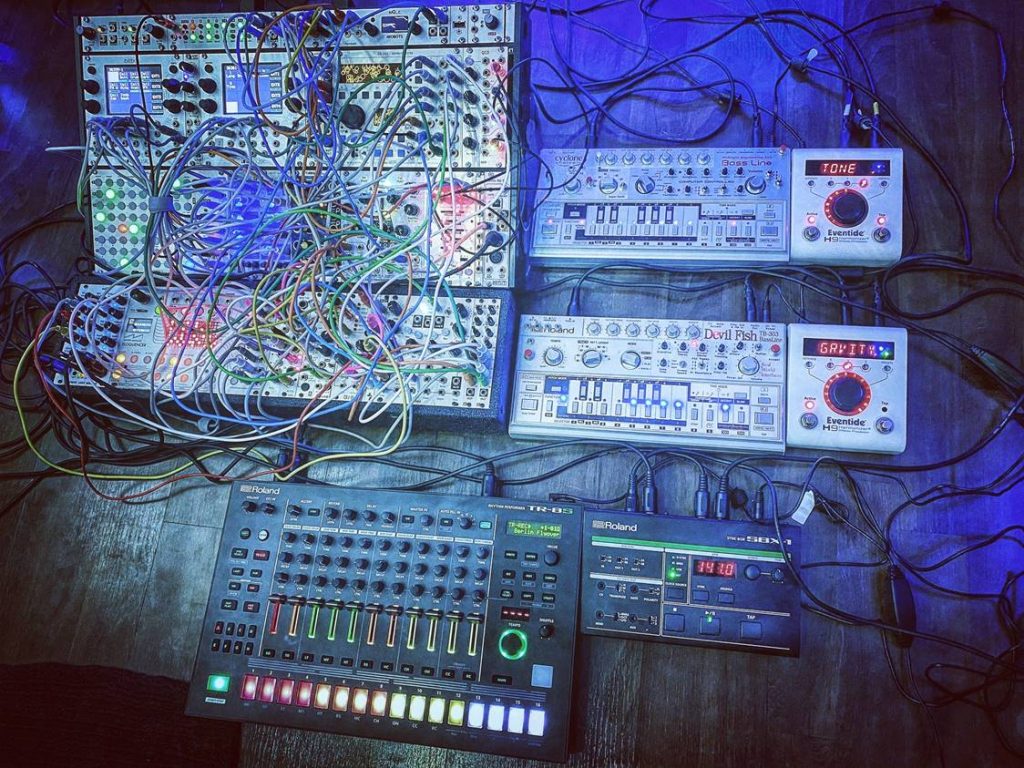
The Early Days
Who were some of your childhood influences, and did you have any formal training?
I started out taking classical piano lessons at the early age of 8. From there, I took lessons on other instruments including guitar, bass, and drums. I played in high school bands. Still, I could never get any group of friends to stick together long enough to keep anything going. So, I gave up and bought a drum machine.
Funny enough, my first real drum machine was the Roland TR-909 I bought used from a friend in 1992. The drum machine was the sequencer behind my first record that came out on Drop Bass Network/SixSixtySix in 1994.
How did you first get into electronic music? Was there any scene in Atlanta?
I got into electronic music around 1989, listening to early industrial bands like Coil, Skinny Puppy, and Meat Beat Manifesto. From there, I attended raves in the early ’90s where I got introduced to the sound of Detroit techno and acid house. Some early influences were Drexciya, Model 500, and Mike Banks from Underground Resistance. I loved how alien and futuristic their music was.
Seeking similar music, I discovered Aphex Twin from a remix on Meat Beat Manifesto’s MindStream. I was blown away by his sound. Later, I discovered the label Rephlex records he ran with his partner Grant Wilson. Those early records set the foundation for the artistic direction I wanted to pursue.
Feeding the Sampler
Where did your passion for sound design come from?
My passion for sound design happened by accident, to be honest. I was using a few hardware Akai samplers in the early ’90s. Starting with the Akai S950, S1100, then later S3200XLs, I hunted for sounds to feed my samplers. Back then, I had limited memory. My S3200 only had 32MB of sample storage. Plus, you had to load them from the old computer floppy discs. That meant you had to choose your sounds wisely. It trained my ears on what to record and use for my songs.
I began buying portable recorders. The first was the Sony TCD-D7. Later, I moved over to the MiniDisc media. At that point, I started cataloging all these tapes and discs full of all kinds of sounds. I had booklets for each category like industrial, nature, mechanical, organic, etc.
"You had to choose your sounds wisely. It trained my ears on what to record and use for my songs."
-Richard Devine
Pawn Shop Gold
Around this time, I started building up a large collection of analog synthesizers. The first was the Arp-2600 and Odyssey. Later, I bought the Jupiter-6 and Jupiter-8, which I still have today. I started studying and making music with all the gear I was buying. During this time, I was able to buy all this gear for next to nothing. In the early ’90s, a lot of these vintage classics showed up second-hand in Atlanta pawn shops.
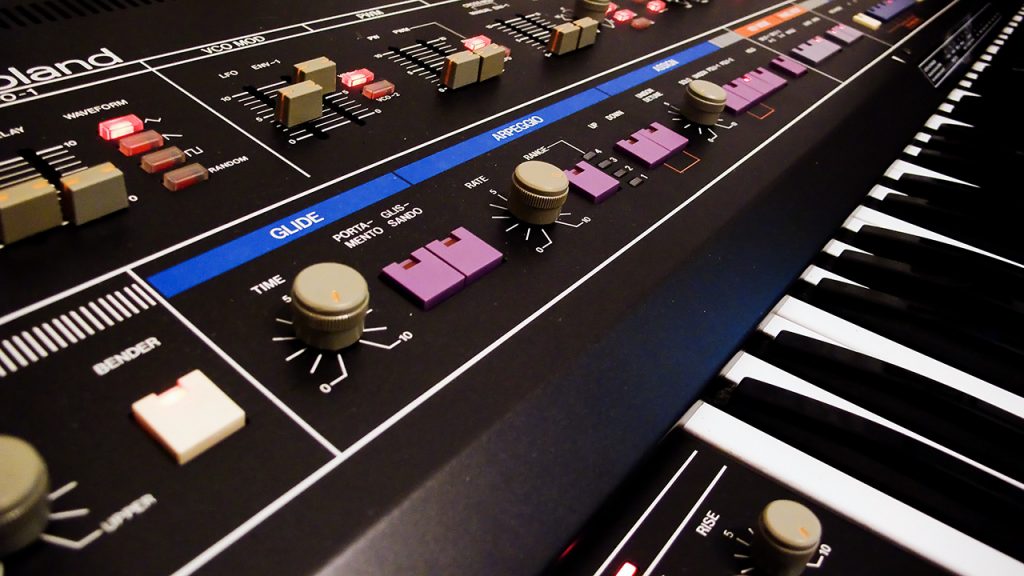
There were a lot of music studios in town. At the time, everyone was switching out their gear for more realistic drums and synths. So, a lot of studios would unload their old analog Junos and TR-808 drum machines to the local shops. That’s how I acquired many of the instruments I have today. That period was research and developmental time. I studied each synthesizer, trying to understand how each one worked. With each synth, I started recording dozens of 2-hour DAT tapes learning to make as many sounds as I could.
Sometimes, I’d sample them and then use them on a track along with other sequencers. With this gear, I started building up my first studio tracks. I also acquired a Roland MC-4 sequencer that I used with my Roland Jupiter-4 and MC-202.

Discovering the Bass Line
When did you first hear the TB-303?
I believe it was in 1992 when I first heard the TB-303. I was starting to listen to a lot of early acid house and acid techno. One record that stood out to me was the Stakker Humanoid EP on Jumpin’ & Pumpin’. I remember hearing the bassline thinking about how futuristic and different it was. Instantly, I fell in love with the liquid grooving rhythm of the 303. From then on, I started to seek out other music like that.
"The 303 is one of the most unique analog bass sounds I've ever heard. I love how it can go from super-smooth to gritty and elastic."
-Richard Devine
Where did you buy your first TB-303, and how much did you pay for it?
My first 303 I bought in 1993. I got it through a friend that was selling a TR-606 and 303 together. I believe I only paid around $350 for the 303. Maybe $150 for the 606. Not much at the time. I still have that 303 today, and in 2005 had the Devilfish modification done to it while in Australia on tour. Also, Alien Devices modified my TR-606. There were only 5 or 6 of these made—I still use both of those machines to this day.
What do you love about the 303 sound?
To me, the 303 is one of the most unique analog bass sounds I’ve ever heard. So fluid and organic, yet can sound vocal-like at times. It cuts through a mix so well, and when you hear it layered against a drum track it creates an instant hypnotic feel. I love how it can go from super-smooth to gritty and elastic with one flip of a switch.
The sequencer is unique and unlike anything I’ve ever used. I’ve since gotten another 303, and many clones. It’s been a sound that will forever have a close place in my heart.
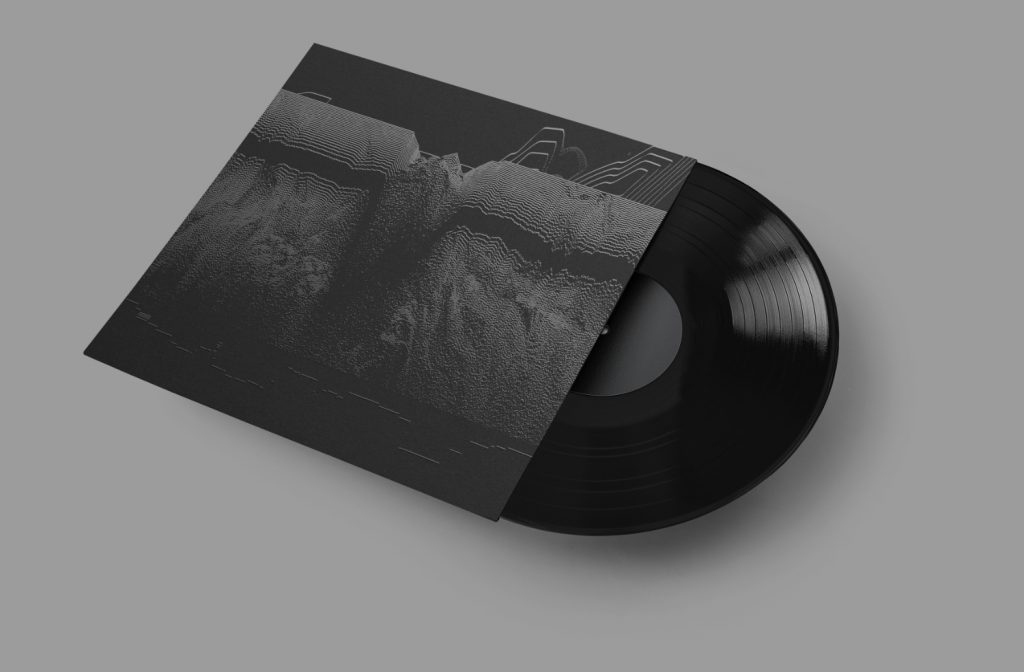
Acidic State
Can you tell us about the title for the new EP, Systik?
The title Systik comes from the default clock source for the SysTick timer from a Cortex-M CPU clock. System Tick Time (SysTick) generates interrupt requests (IRQs) regularly. This idea of generating different interrupted clock signals to create new polyrhythms on a grooving drum track fascinated me.
I wanted to design a live show that played around with this idea. This EP came from the new live show I intended to play out this year. Since COVID-19 happened, I could only play two shows with the new material.
"This idea of generating different interrupted clock signals to create new polyrhythms on a grooving drum track fascinated me."
-Richard Devine
I should note that I never had any intention of releasing this music other than playing it live. My friend Surachai said, ‘Why not release this EP as a live acid record?’ The idea never crossed my mind until he brought it up. So, I asked myself, “What if I tried to record the entire live set in one take and see what happens?”
What ended up on the record is a 46-minute live multi-track recorded session of my show that I did in my studio. It took me about 4 or 5 attempts before I got the one I thought was good enough to put on vinyl. I had to cut the tracks into different parts to arrange them for vinyl. Originally, it was one long track that morphed into different sections.

In and Out of the Box
What was it like to make an album primarily “out of the box” with hardware?
I’ve been making music this way since 2012, using Eurorack modular and other similar tools. For this record, I limited myself to a smaller set of tools and pushed them to the limit to see what would happen. The idea was to keep it to four or five pieces of gear. Since it was going to be my live show, I figured I should only use gear I could take with me on an airplane.
Also, I wanted to revisit the sound of acid music which I hadn’t made in over 25 years. I was curious to try and make this music again with a different set of tools and a different frame of mind. The result was very interesting. It’s a juxtaposition of complex beats and textures with 303 patterns mutating into various sonic spaces. That’s why the tracks are so long. Many of the songs sort of blend together like a DJ mix, going from one idea into another.
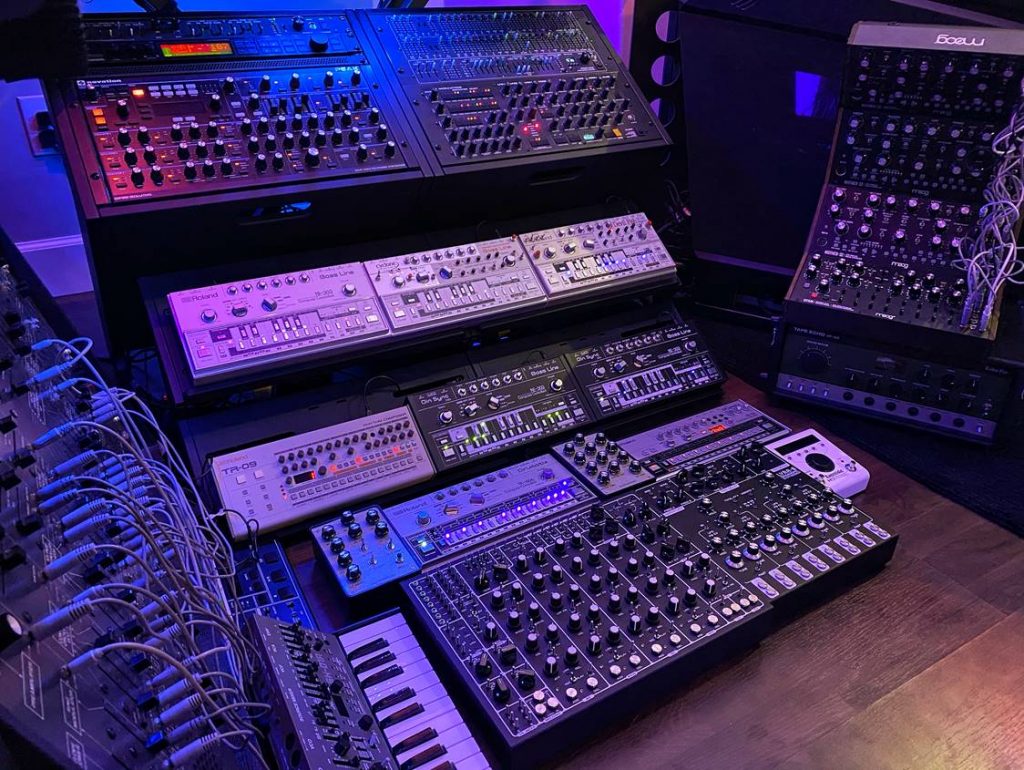
Modular Life
You have a huge modular/hardware setup in your studio. How did you choose the pieces to take out to perform live/make the album with?
As I mentioned, I restricted myself to what I could take out in a live situation. This limited my tools to what I could pack as carry-on luggage. For the actual setup, I used the Roland TR-8S and the SBX-1 as my main sync box to clock my two 303s, drum machine, and modular together.
I used the Synthrotek MST MIDI to CV module that can take USB or MIDI clock input and convert that to MIDI clock or Gate output to my modular. Then, I multiplied the clock signal to a 4ms Quad Clock distributor module. That could either run 4 extra clocks at multiplications or divisions of the master clock signal.
"I restricted myself to what I could take out in a live situation. This limited my tools to what I could pack as carry-on luggage."
-Richard Devine
Next, I took that signal and sent it to the Tiptop Circadian Rhythms and Winter Modular Eloquencer. It did a lot of the internal glitchy broken patterns triggering two 1010 music Bitbox sampler modules and one ER-301. I also used a module by North Lights Modular called “EvenMidi 3U – Model euEM V2.
This allowed me to control two Eventide H9 effects pedals with control voltages that could animate in time with my tracks. There are 10 CV controls, and I would separate 5 controls for each pedal that each 303 was running into. That meant I could creatively move and control the reverbs and delays in interesting ways.
Welcome to the Machines
How do you not get lost in the machines while playing live?
The best bit of advice here is to take in one piece at a time. I digest learning pieces of equipment better if I focus on one thing for a few weeks. See what that one instrument can do and try to create as many sounds as possible. One exercise I like to do with a new synth is to see if I can make an entire song using only that machine. You’ll quickly see the strengths and weaknesses of that synth.
Another way to avoid confusion is to reduce the number of machines in your setup. It’s better for troubleshooting if something goes wrong. Plus, I always try to have a backup system in case something goes down.
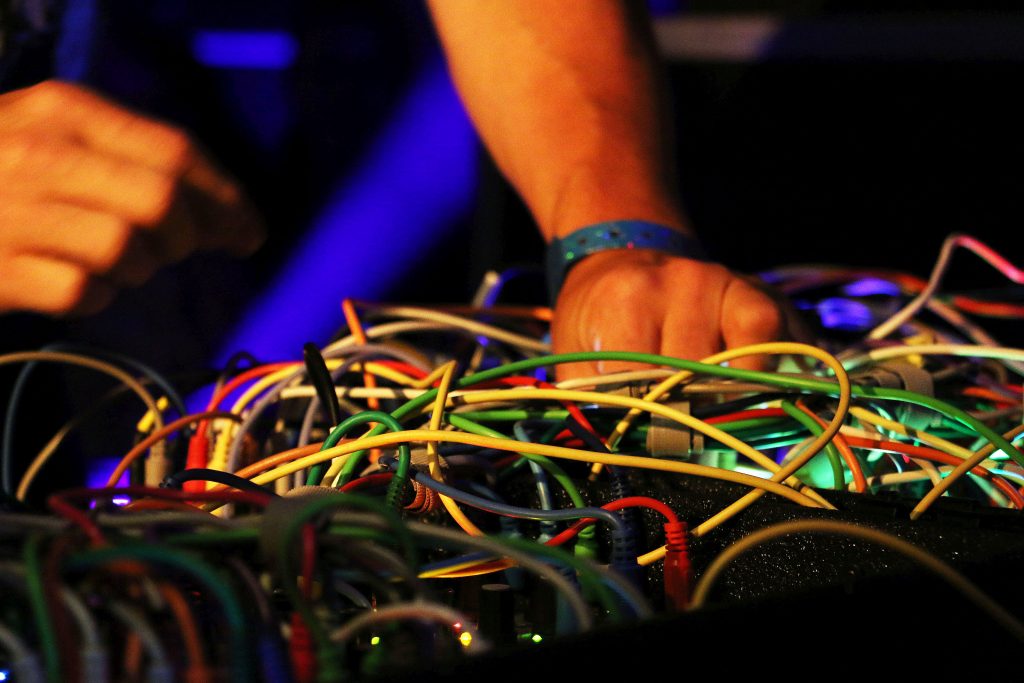
Stay a Student
What’s the best advice you could give to aspiring artists, producers, composers, or sound designers?
I’ve said it many times before, but I consider myself a student for life. I never stop wanting to learn new things and new ways of making music. This could be a new approach to a piece of gear or a fresh way of thinking about something. I’m on a constant quest to create new and interesting sounds I’ve never heard before.
As an artist, I try and push myself to try new things, and also try to find the time to make new music every day. Even if it’s a short two-minute track, I always try and write something new.
Inspiration and Algoraves
Are there any current composers or electronic artists doing things that are inspiring you right now?
Yes, I am digging Autechre’s latest record SIGN. I have also been listening to a lot of music by Grischa Lichtenberger, Kindohm, and William Fields. I dig what Mike Hodnick has been doing lately. He is working with this software called Tidal Cycles and has been doing what people call “live coding.” I’ve recently experimented with this new technique.
There’s an underground movement happening called “Algorave.” The name comes from the terms “algorithm” and “rave.” It’s an event where people dance to music generated by algorithms, often using live coding techniques. Algorave music contains many styles, including forms of minimal techno, experimental, and IDM.
"Sometimes a total change of scenery is all it takes to get you back in the right headspace."
-Richard Devine
Finally, any tips for staying creative during this time?
I’d say try to get out and go on a hike. Get back into nature. It’s been great for me to escape the studio with my wife and kids, get some fresh air, and reset the brain. We’ve been doing weekly hikes on the weekends to waterfalls and different parks. It’s helped me stay refreshed and creative during this time. Sometimes a total change of scenery is all it takes to get you back in the right headspace.
Richard Devine created a pair of modular kits for the TR-6S and TR-8S. Download them below.

